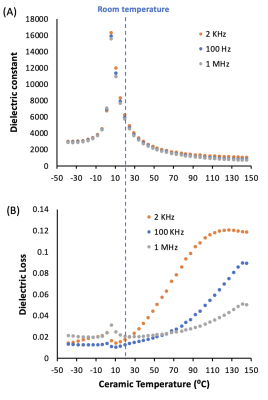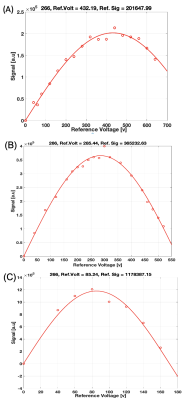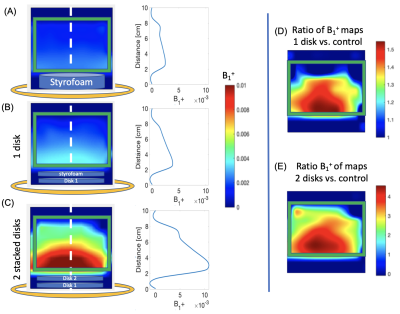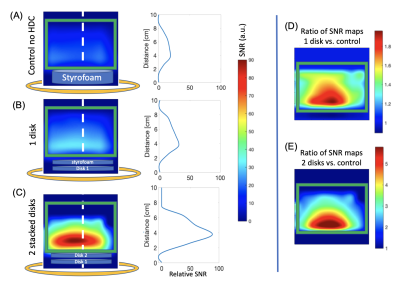1808
New tuHDC BST-BT Ceramics with Optimal Permittivity Greatly Improve B1 efficiency and SNR at Room Temperature for 17O MRSI Application at 10.5T
Hannes Michel Wiesner1, Xiao-Hong Zhu1, Maryam Sarkarat2, Xin Li1, Matt Waks1, Michael T. Lanagan2, Qing X. Yang3, and Wei Chen1
1CMRR, Department of Radiology, University of Minnesota, Minneapolis, MN, United States, 2Department of Engineering, Pennsylvania State College of Engineering, University Park, PA, United States, 3CNMRR, Department of Neurosurgery, Penn State University, Hershey, PA, United States
1CMRR, Department of Radiology, University of Minnesota, Minneapolis, MN, United States, 2Department of Engineering, Pennsylvania State College of Engineering, University Park, PA, United States, 3CNMRR, Department of Neurosurgery, Penn State University, Hershey, PA, United States
Synopsis
Recently we reported that the ceramics made of composite BST (Ba0.6Sr0.4TiO3) material have an extremely high tunability of relative permittivity when changing the ceramic temperature; and by cooling the ceramics to 14-15 °C, they provided the best improvement for 17O MRSI application at 10.5T, resulting in an optimal permittivity of ~6000. In this study, we developed new ceramic disks made of mixed Ba0.6Sr0.4TiO3 and BaTiO3 (BST-BT) materials to achieve the optimal permittivity at room temperature. The results indicate that unprecedented performance is possible for 17O MRSI application at 10.5T without the need of a temperature controller.
Introduction
Achieving higher spatiotemporal resolution and detection sensitivity in MRI and MRSI application is of great importance for non-invasively assessing brain structure, function and metabolism. However, the signal-to-noise ratio (SNR) is still limited even at ultrahigh field (UHF). One RF engineering approach that integrated high or ultrahigh dielectric constant (HDC or uHDC) materials with RF coil(s) has proven to improve RF coil transmission (B1+) and reception (B1-) fields, thus, SNR.1-5 Recently, we reported that the tuHDC ceramics made of composite BST (Ba0.6Sr0.4TiO3) material have an extremely high tunibility of relative permittivity (εr) from a few thousands to >15000 when changing a few degree of the ceramic temperature.1 We found that 14-15 °C is the best ceramic temperature for 17O MRSI application at 10.5T, resulting an optimal permittivity of ~6000. In this study, we developed new ceramic disks made of mixed Ba0.6Sr0.4TiO3 and BaTiO3 (BST-BT) materials to achieve an optimal permittivity (εr»6000) at room temperature for 10.5T 17O MRSI application without the need of temperature controller. The performance and improvement of 10.5T 17O MRSI using the BST-BT-based ceremics have been rigorously evaluated and quantified.Methods
Two circular uHDC disks (8-cm diameter, 0.9-cm thickness) with extremely high permittivity (εr»6000, Fig.1A) and a very low dielectric loss, thus a high Q (Fig. 1B, Table 1) at the room temperature (20°C) were made from mixed composite material (Ba0.6Sr0.4TiO3 + 10% w/t BaTiO3).17O MRSI experiments were carried out on a Siemens 10.5T whole-body/88-cm human scanner with a single-loop 17O RF coil (15cm diameter) operating at 60.6 MHz. 3D 17O-CSI data were acquired under fully relaxed conditions (TR = 0.2s, 2ms hard pulse, flip angle (FA)=90°, Matrix=9×9×7, spectral bandwidth=30kHz, FOV=10×10×10 cm3, voxel size = 1.1×1.1x1.4 mm3, number of points = 1024). Three conditions were investigated at room temperature: (i) control condition without the uHDC disk, (ii) with one tuHDC disk and (iii) stacking two tuHDC disks together. To quantify the B1 fields and SNR, we collected multiple 17O CSI datasets with varied RF pulse voltages from a water phantom (9-cm diameter, 7.2-cm height, 50 mM NaCl). The tuHDC disks were placed between the phantom and the coil plane and Styrofoams were used to replace the disk(s) for keeping the distance between the phantom and coil same in all cases. All results were compared to the control condition. B1 maps were processed with sinusoidal fitting and interpolated for visualization using standard matlab routines (interp2, makima), and more details can be found in the literature.1 The SNR value was calculated using the maximum H217O signal at 90° FA divided by the spectral baseline (std) noise.
Results
Self-resonance frequency of each disk was in the range of 82-87 MHz, however, when two disks were stacked together, it dropped to 65 MHz, which was close to the 17O Larmor frequency (61 MHz). Figure 1 depicts the ceramic temperature dependence of (A) permittivity showing an optimal of εr»6000 at room temperature and a much higher εr at Curie temperature around 8°C; and (B) dielectric loss (tanδ) showing a minimum loss or excellent Q around room temperature. Figure 2 demonstrate representative sinusoidal fittings of the 17O water signals as a function of pulse voltage in a central voxel to determine B1+ and SNR values; similarly, the B1+and SNR maps were generated for the three conditions. Figures 3-4 show the results of B1+ and SNR maps and their 1D profiles along the depth for demonstrating and quantifying the improvements with one or two BST-BT-based tuHDC disks. Strikingly, we observed approximately 5 times higher B1+ and SNR near the two-stacked uHDC disks as compared to the control without the disk. For the single disk condition, we also observed moderate improvement of B1+ and SNR (>50%) compared to the control despite of a large gap between the disk and the imaging object (Figs. 3&4).Discussion
In this study, we have demonstrated unprecedented improvements on transmission efficiency and reception sensitivity using the newly developed and optimized ceramic disks made of BST-BT composite materials. The magnitude of improvement depends on the disk permittivity and size or thickness. Future research will include RF simulation to elucidate optimal disk design for particular applications of interest with further improvement.8,9 The same concept of designing optimal HDC/uHDC ceramics via material science and fabrication could be employed to other field strengths or other nuclide applications. One particular interesting and straightforward application of the same BST-BT tuHDC disks is to improve the 1H MRI/MRSI performance at clinical field strength of 1.5T since the 1H Larmor frequency at 1.5T is almost identical as the 17O Larmor frequency at 10.5T.1Conclusion
We report the newly developed BST-BT ceramics can provide unprecedented improvement at room temperature for 17O MRSI applications using a 10.5T human scanner. The novel uHDC-RF coil technology could greatly enhance the spatiotemporal resolution and detection sensitivity for X-nuclear application at UHF and 1H MRI/MRSI at clinical scanners without temperature controlling. This could reduce the gap between the uHDC-RF coil and the imaging object and make the uHDC-RF coil design, construction less complicated; thus, accerelate the translation.Acknowledgements
Acknowledgment: This work was supported in part by NIH grants of U01 EB026978, R01 MH111413, R01 CA240953, R24 MH106049, S10 RR026783, P41 EB027061 and P30 NS076408.References
References [1] Chen et. al. IEEE-TMI (2020) [2] Yang et al. JMRI 24, 197-202 (2006). [3] Haines et al. JMR 203, 323-327 (2010). [4] Yang et al. MMR 65, 358-362 (2011). [5] Lee et al., MRI 42, 158-163 (2017). [6] Rupprecht et al. MRM 79, 2842-2851 (2018). [7] Koolstra al., MRM 79, 1192-1199 (2018). [8]. Cohick et al Applied Phys. Express (2016). [9] Shchelokova et al., Nat. Comm. (2020)Figures

Figure 1 Temperature dependence of dielectric constant (A) and loss (B) measured in the BST-BT uHDC disks at three measurement frequencies.

Figure 2 Sinusoidal fittings of the H217O signal of a representative voxel for determining B1+ and SNR values under 3 conditions: (A) control without uHDC disks, (B) with 1 uHDC disk, and (C) with 2 uHDC disks. The maximum intensity near 90o flip angle determines SNR and the pulse voltage reaching 90o flip angle is inversely proportional to B1+.

Figure 3 Representative B1+ maps in axial orientation (left panels) and B1+ profiles along the vertical dashed lines acquired under (A) control without the uHDC disks, (B) with one uHDC disk and (C) two stacked disks. The ratio images between (D) one uHDC disk versus control and (E) two stacked disks versus control. The yellow rings represent the 15-cm 17O RF coil.

Figure 4 Representative (relative) SNR maps in axial orientation (left panels) and SNR profiles along the vertical dash lines acquired under (A) control without the uHDC disks, (B) with one uHDC disk and (C) with two stacked disks. The ratio images between one uHDC disk versus control (D) and two stacked disks versus control (E) indicate large SNR improvement. The yellow rings represent the 15-cm 17O RF coil.